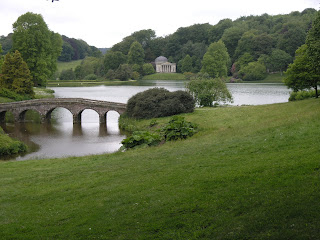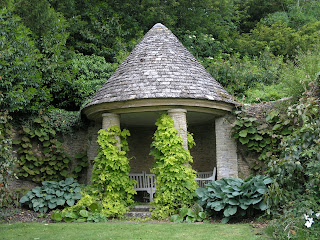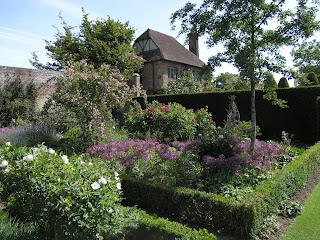English Garden Tour May, 2011
English Garden Tour May, 2011
I recently spent time visiting gardens around England and had a marvelous time with my 14 traveling companions. Travel back with me as I review some of the highlights of the tour. I've provided links to many of the gardens for you and please click on the photos to enlarge them. Once you've finished, be sure to view the Chelsea Flower and Garden Show Post.
Stourhead Garden
The park-like garden of Stourhead was next on our tour. A beautiful garden built in the early 1700’s by the Hoare family, boasts a shimmering lake, classical temples and exotic plants and trees. Most notable to me because this is where the recent movie Pride and Prejudice was filmed. On a rainy overcast day, Elizabeth (Kiera Knightly) refuses Darcy’s (Matthew Macfadyen) wedding proposal in this Temple of Apollo
Bath was a new city to me and although a bit touristy, one of the most magical I've visitedTemple  Hidcote Manor Garden
Hidcote Manor Garden
After lunch at a pub in a beautiful village near Chipping Campden, we arrived at one of England’s most iconic gardens, Hidcote. The designer, an American named Lawrence Johnson, was the first person to perfect the concept of garden rooms . I’ve been to Hidcote many times since the 80’s and unfortunately the garden was not at its best. We had just had a horrific windstorm the day before so some of the unsightliness could have been from the wind damage. The famous red border looked unkempt and the rose gardens were empty and unattended. I ended up exploring some parts of the rose and woodland gardens which are less traveled and I was happy to see these areas were looking well.

Day Lilies bordering a woodland path.
hidcote@nationaltrust.org.uk
Kiftsgate Court Gardens
After Hidcote, our next garden completely enchanted me. I’ve never seen Kiftsgate looking so wonderful. Since my last visit, they had expanded the perennial borders and because of the warm weather, the rose garden was in full bloom. The descendants of the original owner, Heather Muir, still live at Kiftsgate and it’s charming to see them taking tickets and selling plants as you enter the garden. So many of the National Trust gardens now have a commercial feeling so it’s always nice to feel you are experiencing someone’s private garden.
The rose garden at Kitfsgate.
Mill Dene Garden was our first stop this morning. Wendy Dare, one of the editors of The English Garden Magazine, gave us a tour of her garden built around an old mill in yet another picturesque village in the Cotswolds.
 Borders at the Mill Pond.
Borders at the Mill Pond.
www.milldenegarden.co.uk
A secret path to the Old Mill.
English gardens are often full of mystery and around every corner you are likely to find something wonderful like this stone folly at Mill Dene built with the honey-colored stone quarried in the Cotswolds.
After another wonderful lunch in the village of Lower Slaughter, we visited the garden of Lady Lavinia Barring. This garden is a show stopper and we were so privileged to see it since she does not open it to the public. Lavinia, the former Lady in Waiting to Lady Diana Spencer, proved to be very beautiful, down to earth and had baked us brownies and set out tea which she served in the pool house. This garden was full of wonderful elements and completely designed by Lavinia and her gardener.
The rose and perennial garden with the house in the background.
We started our final day of the tour in one of the world’s most celebrated gardens, Sissinghurst Castle. Created by a talented husband and wife team, authors Vita Sackville West and Harold Nicholson, Sissinghurst has much to offer in the way of design and delight. Strong access pathways crisscross the garden which is broken into many garden rooms. Vita actually consulted with Lawrence Johnson on the design of Sissinghurst's garden layout.
www.sissinghurst@nationaltrust.org.uk
The Famous tower from the Rose Garden.
The rose garden was almost in full bloom seen here with the south cottage in the back ground
Nothing is wasted in English Gardens. Tree cuttings are often used to stake plants. As the plant grows, the branches look like a natural part of the plant.
After a wonderful lunch at the Sissinghurst cafe, we headed to Great Dixter. The late Christopher Lloyd can be proud of how Great Dixter is holding up without him. Here you see the famous long perennial border with the house in the background designed by the 19th century architect Sir Edwin Lutyens.
Head Gardener Fergus Garrett is doing a great job maintaining Dixter's character. This garden is known for Lloyd’s vibrant and wild use of color and the gardens still reflect his philosophy.
www.greatdixter.co.uk
Oast House Barn at Dixter
These Oast houses were used to smoke the Hops for brewing beer but have mostly been converted into homes and barns. Ten years ago you would see fields of Hops as you drove around Kent. Now the old Hop fields are fruit tree farms.
I recently spent time visiting gardens around England and had a marvelous time with my 14 traveling companions. Travel back with me as I review some of the highlights of the tour. I've provided links to many of the gardens for you and please click on the photos to enlarge them. Once you've finished, be sure to view the Chelsea Flower and Garden Show Post.
May 18 - Windsor
After I spent a few days on my own in London researching hotels for 2012 , our tour group convened in the beautiful Village of Windsor Castle
May 19 - RHS Wisley
If you only had a couple of hours during a stay in London Royal Horticulture Society Garden , an hour train ride from London
www.rhs.org.uk/wisley
Designer Penelope Hobhouse designed this rose garden for Wisley in 2005.
The rock garden and Alpine Meadow celebrated its 100th anniversary this year and looks so natural you’d never know it was man-made.
Tucked into this massive garden are many intimate spaces for rest and reflection.
A path through the large collection of Azaleas and Rhododendrons on Battleston Hill.
Danish designer Piet Oudolf designed these perennial borders leading to the new Glasshouse Arboretum dedicated in 2007.
Detail of the Piet Oudolf borders. These few plants are repeated down the long border for dramatic effect.
Off to work we go!
Vann House Garden
After a short drive through theSurrey country side, we visited Vann House, a 15th century Tudor home and garden. This garden was part of the Open Days Scheme which holds open days at private gardens for charity during the summer. The English are proud of their historical homes and this one was a beauty. It’s amazing to think that King Henry VIII was alive when this house was built.
Off to work we go!
Vann House Garden
After a short drive through the
The pond.
Normally, June 15 is the height of the rose season but due to the unseasonably warm weather in England
Today we traveled southwest to Exbury Gardens
The lake at Exbury.
One of the many ponds and small waterfalls winding through Exbury.
The Primulas were blooming along the streams.
The border garden at Exbury with the estate in the background.
Edmondsham House Garden
After Exbury, we visited another private garden as we traveled to our hotel in the Cotswold’s. Edmondsham, House is also a Tudor manor with a wonderful walled garden and a most charming head gardener named Andrew. He gave us a tour of the garden and its beautiful perennial borders and vegetable garden.
After Exbury, we visited another private garden as we traveled to our hotel in the Cotswold’s. Edmondsham, House is also a Tudor manor with a wonderful walled garden and a most charming head gardener named Andrew. He gave us a tour of the garden and its beautiful perennial borders and vegetable garden.
Entrance to the walled garden.
Peonies in the walled garden.
One of the borders in the garden.
Path through the borders at Edmondsham.
These ancient Staddle stones were used to raise granaries off the ground to keep them dry and vermin free.
May 21 - Stonehenge, Stourhead and Bath
Rarely have I been touched so emotionally by a tourist attraction as I was at Stonehenge , our first stop this morning. This tumble of monolithic stones took my breath away and gave me a profound realization of man’s deep, visceral attraction to stone. In our gardens today, we use the same construction principles that were used to build Stonehenge . Everywhere in England you see the results of Stonehenge from the stacked walls in the Cotswolds, to Andrew Goldsworthy’s work, to the stone work and garden designs at Chelsea
Mystical Stonehenge.Stourhead Garden
Apollo's Temple, scene of the 'brush off' in Pride and Prejudice.
The Gothic Cottage where a family of 9 lived in the 1700's. This space was no more than 15'x15'.
Village Chapel at Stourhead.
After a leisurely walk around the lake, we had Asparagus soup and warm bread at the Stourhead village pub. One thing I've noticed is that the English are not only great gardeners, but frequent garden visitors. Stourhead was full of families just enjoying a walk on a sunny day.
Roman Baths and Tea in the Pump Room
The original Sacred Spring from Roman times is still gurgling from the earth at between 64 and 98 degrees Fahrenheit. My real treat was the adjoining Pump Room where we had tea…the works, scones, tiny sandwiches and sweets. As I closed my eyes, I could see Jane Austen’s characters taking the waters at the Pump Room fountain as they did in her novel Persuasion.
May 22 - The Cotswolds
After breakfast we visited the private estate of the author Jilly Cooper, best known for her ‘bodice ripping’ romantic novels. A charity plant sale was held on her estate in the Cotswolds. This is horse country and tourist buses are strongly encouraged not to travel on these roads and are frequently reported and turned back. Our coach driver Mick, with the help of his GPS, took the most obscure back roads possible and got us to our destination. The house, grounds and gardens were immense and lovely. I’ve never seen so many Land Rovers and riding boots in my life!
The Cooper home.
Plants and people galore. There were no commercial nurseries here. Most of these plants were propagated by each seller.
Entering the plant sale from the Car Park.
A folly from Jilly Cooper’s walled garden.

The walled garden borders with house in the background.
After lunch at a pub in a beautiful village near Chipping Campden, we arrived at one of England’s most iconic gardens, Hidcote. The designer, an American named Lawrence Johnson, was the first person to perfect the concept of garden rooms . I’ve been to Hidcote many times since the 80’s and unfortunately the garden was not at its best. We had just had a horrific windstorm the day before so some of the unsightliness could have been from the wind damage. The famous red border looked unkempt and the rose gardens were empty and unattended. I ended up exploring some parts of the rose and woodland gardens which are less traveled and I was happy to see these areas were looking well.

Day Lilies bordering a woodland path.
hidcote@nationaltrust.org.uk
Kiftsgate Court Gardens
After Hidcote, our next garden completely enchanted me. I’ve never seen Kiftsgate looking so wonderful. Since my last visit, they had expanded the perennial borders and because of the warm weather, the rose garden was in full bloom. The descendants of the original owner, Heather Muir, still live at Kiftsgate and it’s charming to see them taking tickets and selling plants as you enter the garden. So many of the National Trust gardens now have a commercial feeling so it’s always nice to feel you are experiencing someone’s private garden.
The rose garden at Kitfsgate.
The borders were magnificent here in the fountain garden. The Hosta leaves were the size of dinner plates and not a snail in sight!
The long border was filled with Astrantia, Meadow Rue, Geranium ‘Rozanne’, Penstemon, Anemone, and Salvia.
May 23 - Mill Dene Garden and Lady Livinia Barring’s GardenMill Dene Garden was our first stop this morning. Wendy Dare, one of the editors of The English Garden Magazine, gave us a tour of her garden built around an old mill in yet another picturesque village in the Cotswolds.
 Borders at the Mill Pond.
Borders at the Mill Pond.www.milldenegarden.co.uk
A secret path to the Old Mill.
English gardens are often full of mystery and around every corner you are likely to find something wonderful like this stone folly at Mill Dene built with the honey-colored stone quarried in the Cotswolds.
The vegetable garden at Mill Dene.
Lady Lavinia BarringAfter another wonderful lunch in the village of Lower Slaughter, we visited the garden of Lady Lavinia Barring. This garden is a show stopper and we were so privileged to see it since she does not open it to the public. Lavinia, the former Lady in Waiting to Lady Diana Spencer, proved to be very beautiful, down to earth and had baked us brownies and set out tea which she served in the pool house. This garden was full of wonderful elements and completely designed by Lavinia and her gardener.
The rose and perennial garden with the house in the background.
This raised boarder is a great example of ‘simplify and repeat’ with the purple Lupine, Yew and Chartreuse Acacia.
Pool and pool house above left in the background.
The vegetable garden was a great example of succession planting.
May 24 - Sissinghurst Castle Garden and Great DixterWe started our final day of the tour in one of the world’s most celebrated gardens, Sissinghurst Castle. Created by a talented husband and wife team, authors Vita Sackville West and Harold Nicholson, Sissinghurst has much to offer in the way of design and delight. Strong access pathways crisscross the garden which is broken into many garden rooms. Vita actually consulted with Lawrence Johnson on the design of Sissinghurst's garden layout.
www.sissinghurst@nationaltrust.org.uk
The Famous tower from the Rose Garden.
The rose garden was almost in full bloom seen here with the south cottage in the back ground
Nothing is wasted in English Gardens. Tree cuttings are often used to stake plants. As the plant grows, the branches look like a natural part of the plant.
What a surprise! Ran into my clients, Mother and Daughter, Cara Dakin and Sherry Bakun at Sissinghurst.
Great DixterAfter a wonderful lunch at the Sissinghurst cafe, we headed to Great Dixter. The late Christopher Lloyd can be proud of how Great Dixter is holding up without him. Here you see the famous long perennial border with the house in the background designed by the 19th century architect Sir Edwin Lutyens.
Head Gardener Fergus Garrett is doing a great job maintaining Dixter's character. This garden is known for Lloyd’s vibrant and wild use of color and the gardens still reflect his philosophy.
www.greatdixter.co.uk
Oast House Barn at Dixter
These Oast houses were used to smoke the Hops for brewing beer but have mostly been converted into homes and barns. Ten years ago you would see fields of Hops as you drove around Kent. Now the old Hop fields are fruit tree farms.
This brightly colored poppy, Papaver rhoeas, was everywhere at Great Dixter.
Meadows play prominently at Great Dixter and they have an extensive training program to spread the word about the importance of meadows for birds and wildlife.
The famous topiary in the perennial garden.
Reflections
I saw much and learned so much on this trip that I could never set it all down in words. I decided to join this tour of the gardens of Southern England, the Cotswold and the Chelsea Flower Show to not only enhance my skills as a designer, but also to do a bit of comparison with my garden tours. I had a marvelous time and learned that I can be proud in the knowledge that my tours compare very well with the best of them. I can even say that my hotel and restaurant selections are superior.
I saw much and learned so much on this trip that I could never set it all down in words. I decided to join this tour of the gardens of Southern England, the Cotswold and the Chelsea Flower Show to not only enhance my skills as a designer, but also to do a bit of comparison with my garden tours. I had a marvelous time and learned that I can be proud in the knowledge that my tours compare very well with the best of them. I can even say that my hotel and restaurant selections are superior.
Although the National Trust gardens like Sissinghurst and Hidcote are marvels and one should see them, combining private gardens with these iconic gardens really gives a tour depth and richness.
I hope you’ll consider joining me next year for the RHS Chelsea Flower Show and Garden Tour, May 20 to June 1, 2012! Details to follow this fall.
If you've enjoyed the travelog, please view the Chelsea Flower and Garden Show Post!
If you've enjoyed the travelog, please view the Chelsea Flower and Garden Show Post!

































































